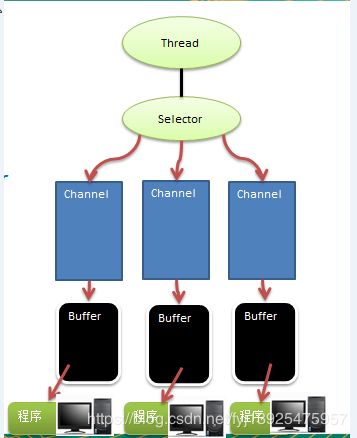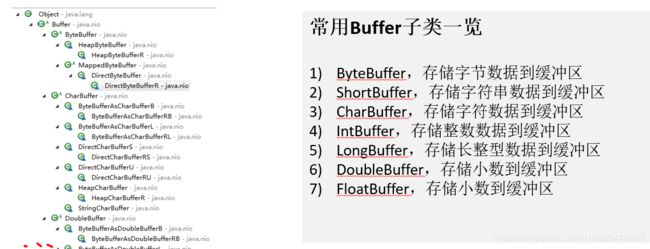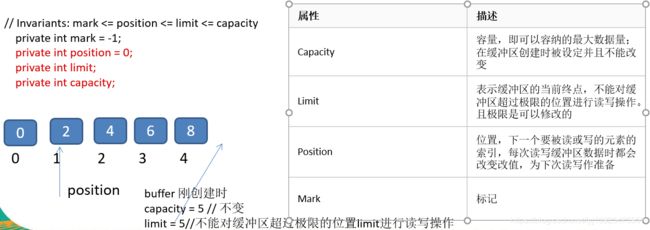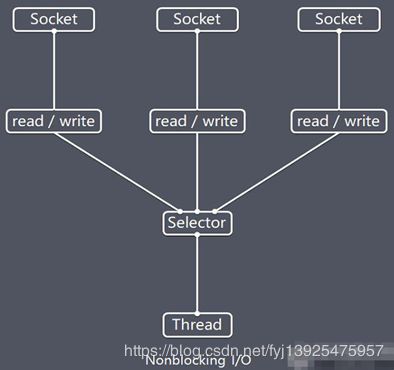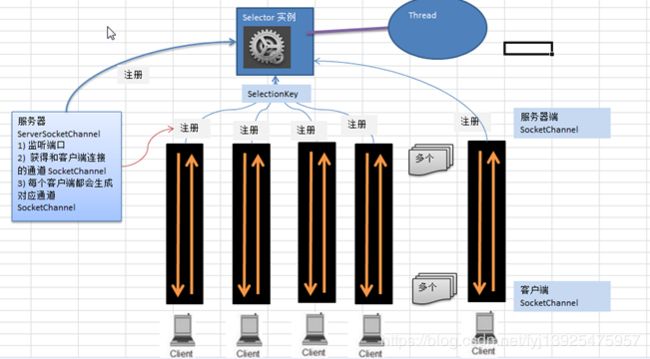netty学习笔记02 - java NIO详解
java NIO基本介绍
-
Java NIO 全称 java non-blocking IO,是指 JDK 提供的新 API。从 JDK1.4 开始,Java 提供了一系列改进的输入/输出的新特性,被统称为 NIO(即 New IO),是同步非阻塞的
-
NIO 相关类都被放在 java.nio 包及子包下,并且对原 java.io 包中的很多类进行改写。
-
NIO 有三大核心部分:Channel(通道),Buffer(缓冲区), Selector(选择器)
-
NIO是 面向缓冲区 ,或者面向 块 编程的。数据读取到一个它稍后处理的缓冲区,需要时可在缓冲区中前后移动,这就增加了处理过程中的灵活性,使用它可以提供非阻塞式的高伸缩性网络
-
Java NIO的非阻塞模式,使一个线程从某通道发送请求或者读取数据,但是它仅能得到目前可用的数据,如果目前没有数据可用时,就什么都不会获取,而不是保持线程阻塞,所以直至数据变的可以读取之前,该线程可以继续做其他的事情。 非阻塞写也是如此,一个线程请求写入一些数据到某通道,但不需要等待它完全写入,这个线程同时可以去做别的事情。
-
通俗理解:NIO是可以做到用一个线程来处理多个操作的。假设有10000个请求过来,根据实际情况,可以分配50或者100个线程来处理。不像之前的阻塞IO那样,非得分配10000个。
-
HTTP2.0使用了多路复用的技术,做到同一个连接并发处理多个请求,而且并发请求的数量比HTTP1.1大了好几个数量级。
NIO和BIO的比较
- BIO 以流的方式处理数据,而 NIO 以块的方式处理数据,块 I/O 的效率比流 I/O 高很多
- BIO 是阻塞的,NIO 则是非阻塞的
- BIO基于字节流和字符流进行操作,而 NIO 基于 Channel(通道)和 Buffer(缓冲区)进行操作,数据总是从通道读取到缓冲区中,或者从缓冲区写入到通道中。Selector(选择器)用于监听多个通道的事件(比如:连接请求,数据到达等),因此使用单个线程就可以监听多个客户端通道
NIO三大核心原理示意图
- 每个channel 都会对应一个Buffer
- Selector 对应一个线程, 一个线程对应多个channel(连接)
- 该图反应了有三个channel 注册到 该selector //程序
- 程序切换到哪个channel 是有事件决定的, Event 就是一个重要的概念
- Selector 会根据不同的事件,在各个通道上切换
- Buffer 就是一个内存块 , 底层是有一个数组
- 数据的读取写入是通过Buffer, 这个和BIO , BIO 中要么是输入流,或者是 输出流, 不能双向,但是NIO的Buffer 是可以读也可以写, 需要 flip 方法切换
- channel 是双向的, 可以返回底层操作系统的情况, 比如Linux , 底层的操作系统 通道就是双向的.
缓冲区(Buffer)
-
基本介绍
缓冲区(Buffer):缓冲区本质上是一个可以读写数据的内存块,可以理解成是一个容器对象(含数组),该对象提供了一组方法,可以更轻松地使用内存块,缓冲区对象内置了一些机制,能够跟踪和记录缓冲区的状态变化情况。Channel 提供从文件、网络读取数据的渠道,但是读取或写入的数据都必须经由 Buffer
-
Buffer类及其子类
- 代码示例
public class BufferTest {
public static void main(String[] args) {
// 1.创建一个初始容量为5的IntBuffer
IntBuffer intBuffer = IntBuffer.allocate(5);
// 2.向intBuffer存放数据 capacity()返回缓冲区的容量
for (int i = 0; i < intBuffer.capacity(); i++) {
intBuffer.put(i*2);
}
// 将buffer切换,读写切换
intBuffer.flip();
while (intBuffer.hasRemaining()) {
System.out.println(intBuffer.get());
}
}
}
通道(Channel)
- 基本介绍
- NIO的通道类似于流,但有些区别如下:
通道可以同时进行读写,而流只能读或者只能写
通道可以实现异步读写数据
通道可以从缓冲读数据,也可以写数据到缓冲:- BIO 中的 stream 是单向的,例如 FileInputStream 对象只能进行读取数据的操作,而 NIO 中的通道(Channel)是双向的,可以读操作,也可以写操作。
- Channel在NIO中是一个接口public interface Channel extends Closeable{}
- 常用的 Channel 类有:FileChannel、DatagramChannel、ServerSocketChannel 和 SocketChannel。【ServerSocketChanne 类似 ServerSocket , SocketChannel 类似 Socket】
- FileChannel 用于文件的数据读写,DatagramChannel 用于 UDP 的数据读写,ServerSocketChannel 和 SocketChannel 用于 TCP 的数据读写。
- FileChannel类
FileChannel主要用来对本地文件的IO操作,常见方法有:
- public int read(ByteBuffer dst) ,从通道读取数据并放到缓冲区中
- public int write(ByteBuffer src) ,把缓冲区的数据写到通道中
- public long transferFrom(ReadableByteChannel src, long position, long count),从目标通道中复制数据到当前通道
- public long transferTo(long position, long count, WritableByteChannel target),把数据从当前通道复制给目标通道
应用实例:
- 本地文件写数据
使用前面学习后的ByteBuffer(缓冲)和FileChannel,将“Hello,World”写到入到file01.txt文件夹中
public class FileChannelTest01 {
public static void main(String[] args) throws IOException {
// 使用前面学习后的ByteBuffer(缓冲)和FileChannel,将“Hello,World”写到入到file01.txt文件夹中
// 步骤:
// 1.创建一个输出流OutputStream,
FileOutputStream fileOutputStream = new FileOutputStream("D://file01.txt");
// 2.通过输出流获取一个FileChannel通道
FileChannel fileChannel = fileOutputStream.getChannel();
// 3.将字符串"Hello,World"放入到ByteBuffer中
String str = "Hello,World";
ByteBuffer byteBuffer = ByteBuffer.allocate(str.length());
byteBuffer.put(str.getBytes());
// 4.将byteBuffer进行flit,从读状态改到写
byteBuffer.flip();
// 5.将ByteBuffer写入到FileChannel中
int write = fileChannel.write(byteBuffer);
System.out.println("一共写出了"+ write +"字节");
// 6.关闭流
fileOutputStream.close();
}
}
- 本地文件读数据
使用ByteBuffer和FileChannel,将file01.txt中的数据读入,并显示到控制台
public class FileChannelTest02 {
public static void main(String[] args) throws Exception {
// 使用ByteBuffer和FileChannel,将file01.txt中的数据读入,并显示到控制台
// 步骤:
// 1. 获取文件输入流
File file = new File("D://file01.txt");
FileInputStream fileInputStream = new FileInputStream(file);
// 2. 从输入流中获取FileChannel
FileChannel channel = fileInputStream.getChannel();
// 3. 创建ByteBuffer
ByteBuffer byteBuffer = ByteBuffer.allocate((int) file.length());
// 4. 从FileChannel通道中读入数据到ByteBuffer
channel.read(byteBuffer);
// 5.输出到控制台
System.out.println(new String(byteBuffer.array()));
// 6. 关闭流
fileInputStream.close();
}
}
- 使用一个Buffer完成一个文件的读写
使用FileChannel完成一个文件的拷贝
public class FileChannelTest03 {
public static void main(String[] args) throws IOException {
// 使用FileChannel完成一个文件的拷贝
// 步骤:
// 1.创建文件输入流,并获取对应的FileChannel
File file = new File("D://file01.txt");
FileInputStream fileInputStream = new FileInputStream(file);
FileChannel inputStreamChannel = fileInputStream.getChannel();
// 2.创建文件输出流,并获取对应的FileChannel
File outFile = new File("D://file02.txt");
FileOutputStream fileOutputStream = new FileOutputStream(outFile);
FileChannel outputStreamChannel = fileOutputStream.getChannel();
// 3.创建ByteBuffer,将输入流的FileChannel读到ByteBuffer中
ByteBuffer byteBuffer = ByteBuffer.allocate((int) file.length());
int read = inputStreamChannel.read(byteBuffer);
System.out.println("读入数据的数量:" + read);
// 4.反转Buffer,将ByteBuffer的数据写入到输出流的FileChannel中
byteBuffer.flip();
int write = outputStreamChannel.write(byteBuffer);
System.out.println("写入数据的数量:" + write);
// 5.关闭流
fileInputStream.close();
fileOutputStream.close();
}
}
- 拷贝文件TransferFrom方法
要求:使用FileChannel和方法transferFrom()方法完成文件的拷贝
public class FileChannelTest04 {
public static void main(String[] args) throws IOException {
// 使用FileChannel和方法transferFrom()方法完成文件的拷贝
// 步骤:
// 1.获取文件输入流及其通道
File inFile = new File("D://file01.txt");
FileInputStream fileInputStream = new FileInputStream(inFile);
FileChannel inputStreamChannel = fileInputStream.getChannel();
// 2.获取文件输出流及其通道
File outFile = new File("D://file03.txt");
FileOutputStream fileOutputStream = new FileOutputStream(outFile);
FileChannel outputStreamChannel = fileOutputStream.getChannel();
// 3.使用文件输出流的通道的transferFrom()完成拷贝
outputStreamChannel.transferFrom(inputStreamChannel,0, inFile.length());
// 4.关闭流
fileInputStream.close();
fileOutputStream.close();
}
}
- 关于Buffer和Channel的注意事项和细节
- ByteBuffer 支持类型化的put 和 get, put 放入的是什么数据类型,get就应该使用相应的数据类型来取出,否则可能有 BufferUnderflowException 异常。
- 可以将一个普通Buffer 转成只读Buffer
- NIO 还提供了 MappedByteBuffer, 可以让文件直接在内存(堆外的内存)中进行修改, 而如何同步到文件由NIO 来完成.
- 前面我们讲的读写操作,都是通过一个Buffer 完成的,NIO 还支持 通过多个Buffer (即 Buffer 数组) 完成读写操作,即 Scattering 和 Gathering
Selector(选择器)
- 基本介绍
- Java 的 NIO,用非阻塞的 IO 方式。可以用一个线程,处理多个的客户端连接,就会使用到Selector(选择器)
- Selector 能够检测多个注册的通道上是否有事件发生(注意:多个Channel以事件的方式可以注册到同一个Selector),如果有事件发生,便获取事件然后针对每个事件进行相应的处理。这样就可以只用一个单线程去管理多个通道,也就是管理多个连接和请求。【示意图】
- 只有在 连接/通道 真正有读写事件发生时,才会进行读写,就大大地减少了系统开销,并且不必为每个连接都创建一个线程,不用去维护多个线程
- 避免了多线程之间的上下文切换导致的开销
- 特点说明:
- Netty 的 IO 线程 NioEventLoop 聚合了 Selector(选择器,也叫多路复用器),可以同时并发处理成百上千个客户端连接。
- 当线程从某客户端 Socket 通道进行读写数据时,若没有数据可用时,该线程可以进行其他任务。
- 线程通常将非阻塞 IO 的空闲时间用于在其他通道上执行 IO 操作,所以单独的线程可以管理多个输入和输出通道。
- 由于读写操作都是非阻塞的,这就可以充分提升 IO 线程的运行效率,避免由于频繁 I/O 阻塞导致的线程挂起。
- 一个 I/O 线程可以并发处理 N 个客户端连接和读写操作,这从根本上解决了传统同步阻塞 I/O 一连接一线程模型,架构的性能、弹性伸缩能力和可靠性都得到了极大的提升。
- Selector类相关的方法
- public abstract class Selector implements Closeable {
- public static Selector open();//得到一个选择器对象
- public int select(long timeout);//监控所有注册的通道,当其中有 IO 操作可以进行时,将对应的 SelectionKey 加入到内部集合中并返回,参数用来设置超时时间
- public Set selectedKeys();//从内部集合中得到所有的 SelectionKey
}
selector.select()//阻塞
selector.select(1000);//阻塞1000毫秒,在1000毫秒后返回
selector.wakeup();//唤醒selector
selector.selectNow();//不阻塞,立马返还
- 当客户端连接时,会通过ServerSocketChannel 得到 SocketChannel
- Selector 进行监听 select 方法, 返回有事件发生的通道的个数.
- 将socketChannel注册到Selector上, register(Selector sel, int ops), 一个selector上可以注册多个SocketChannel
- 注册后返回一个 SelectionKey, 会和该Selector 关联(集合)
- 进一步得到各个 SelectionKey (有事件发生)
- 在通过 SelectionKey 反向获取 SocketChannel , 方法 channel()
- 可以通过 得到的 channel , 完成业务处理
- 代码案例
编写一个NIO入门案例,实现服务器和客户端的之间的数据的简单通讯
代码如下:
服务器端:
public class NIOServer {
public static void main(String[] args) throws IOException {
// NIO编程的服务端
// 步骤:
// 1. 创建ServerSocketChannel并绑定端口7777,设置为非阻塞
ServerSocketChannel serverSocketChannel = ServerSocketChannel.open();
serverSocketChannel.socket().bind(new InetSocketAddress(7777));
serverSocketChannel.configureBlocking(false);
// 2. 创建Selector选择器,并把ServerSocketChannel注册到Selector选择器中监听accept事件
Selector selector = Selector.open();
serverSocketChannel.register(selector, SelectionKey.OP_ACCEPT);
// 3. 循环轮询选Selector中注册的Channel是否有事件发生,
while (true) {
if (selector.select() == 0) {
// 没有事件发生,跳出此次循环
continue;
}
// 有事件发生,获取发生事件的所有的selectionKeys,并遍历
Set<SelectionKey> selectionKeys = selector.selectedKeys();
Iterator<SelectionKey> iterator = selectionKeys.iterator();
while (iterator.hasNext()) {
SelectionKey selectionKey = iterator.next();
// 4. 处理accept连接事件,使用ServerSocketChannel.accept返回一个连接通道,并注册到Selector中监听read事件,设置为非阻塞
if (selectionKey.isAcceptable()) {
SocketChannel socketChannel = serverSocketChannel.accept();
socketChannel.configureBlocking(false);
socketChannel.register(selector, SelectionKey.OP_READ);
System.out.println("客户端已连接,客户端连接的数量为:"+ selector.keys().size() );
}
// 5. 处理read事件,
if (selectionKey.isReadable()) {
SocketChannel socketChannel = (SocketChannel) selectionKey.channel();
ByteBuffer byteBuffer = ByteBuffer.allocate(1024);
int read = socketChannel.read(byteBuffer);
System.out.println(new String(byteBuffer.array()));
}
// 手动从集合中移动当前的selectionKey, 防止重复操作
iterator.remove();
}
}
}
}
客户端:
public class NIOClient {
public static void main(String[] args) throws Exception{
// NIO编程客户端
//得到一个网络通道
SocketChannel socketChannel = SocketChannel.open();
//设置非阻塞
socketChannel.configureBlocking(false);
//提供服务器端的ip 和 端口
InetSocketAddress inetSocketAddress = new InetSocketAddress("127.0.0.1", 7777);
//连接服务器
if (!socketChannel.connect(inetSocketAddress)) {
while (!socketChannel.finishConnect()) {
System.out.println("因为连接需要时间,客户端不会阻塞,可以做其它工作..");
}
}
//...如果连接成功,就发送数据
String str = "hello, 你好2222~";
//Wraps a byte array into a buffer
ByteBuffer buffer = ByteBuffer.wrap(str.getBytes());
//发送数据,将 buffer 数据写入 channel
socketChannel.write(buffer);
System.in.read();
}
}
